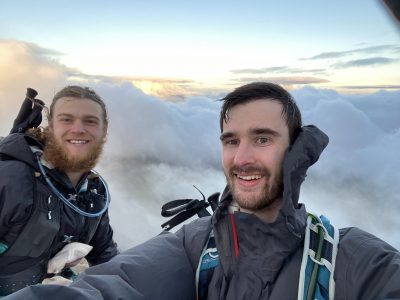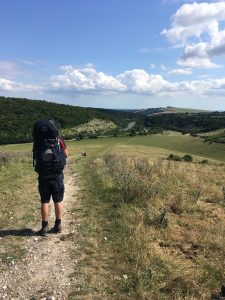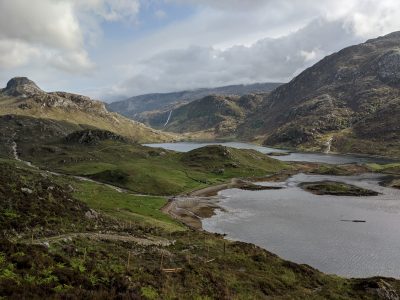The UBES Guide to Austria: Part 2
Grüß Gott liebe UBESters and welcome back to the UBES Guide to Austria. I hear even needing ice axes and crampons to brave the treacherous streets of Bristol didn’t stop you answering the call of pancakes – bravo! If the current UK snowpocalypse or the Winter Olympics have got you psyched about snow then you’re in for a treat, as this time I’ll be focusing on snowsports.
Snowshoeing
Before Christmas I headed back to the Gesäuse with some friends to see it in its winter coat (snow 2 metres deep!). It was our first time snowshoeing so we hired snowshoes from the Alpenverein and chose a pretty easy route up the Lahngangkogel (1778m) – check out the Avalanche Safety section below for the map. Note this area is pretty awkward to get to by public transport, so unless you fancy a long hike in it’s best to hire a car. We stopped at the Oberst-Klinke Hütte (where I stayed in the autumn) to warm up and were astonished to see its transformation since last time – it looked like it was completely buried in snow at first!
Snowshoeing is easily the most accessible of all the sports here – if you can walk then you already know how to snowshoe. Snowshoes strap in to normal walking boots (they don’t need to be winter rated) and modern plastic ones also have spikes on the bottom, with some having more aggressive spike patterns than others (the Alpenverein rental ones are quite basic, so if you’re doing a steep route such as the Hochschwab you’ll want better ones). The spikes work pretty well as basic crampons and you can even front-point with them up steeper sections. It’s astounding what a difference snowshoes make – with them on we were only sinking a few inches into the soft snow, but without them it would really have been a fight to hike through it and we almost certainly wouldn’t have finished the route. One important thing to bear in mind is that because snowshoes allow you to explore areas with much deeper snow, you need to pay more attention to the avalanche risk – see the Avalanche Safety section below for some pointers.
Downhill Skiing
Austrian universities have a month-long semester break in February (don’t be too jealous – we pay for it with lectures and exams through to July) which as far as I can tell is just an excuse to go skiing for a month. And with the perfect snow conditions this year it would be kind of rude not to, really. I skied in the Ski Amadé area (near Salzburg) with family and we had some really spectacular days – here are some of the highlights!
Something that’s come up a fair bit in discussions with UBESters is how to get into skiing. As a broke student in Bristol it seems inaccessible because it can be absurdly expensive: pick a pricey resort and a week’s holiday with gear rental and lessons could easily cost you £1000 if you’re not careful. Personally I’d say don’t even bother going on a ski holiday until you’ve got your basic ski technique sorted – spending so much just to spend all week falling over on the baby slopes is a waste of money. Instead, try learning on a dry ski slope or at an indoor snow dome. My first two years of skiing fun as a kid were on the two pistes at Stoke Ski Centre! Closer to Briz there’s Gloucester Ski Centre, which UBSC run regular trips to for beginners’ lessons, racing and freestyle training. Once you’re ready to hit the pistes in the Alps, your cheapest options are probably UBSC’s uni ski trip, UCPA’s all-inclusive ski packages (I went last year to Chamonix and couldn’t recommend it more! They have special deals for students and it can be even cheaper if you book their last-minute deals for early/late season), or, you know, just move to Austria :’) Crucial ways to save are to pick cheaper resorts (I know I should be recommending Austria here, but the Bulgarian and Slovenian resorts can be super cheap!), self-cater for all your meals (bring a packed lunch), and book your equipment hire in advance online (normally at least a 10% discount).
In terms of recommending Austrian resorts, I can’t help much as I’ve only skied at Stuhleck (a small ski hill between Graz and Vienna) and in the Ski Amadé area (which I’d really recommend if you want lots of varied beginner-intermediate skiing without the high cost of the glitzy resorts further west – it’s not so good if you want very difficult skiing though). There’s a frankly ridiculous range of options…What I can say, however, is that Austrian après-ski is a thing of beauty and that alone is sufficient reason to choose Austria for skiing. Step into a mountain hut and you step into a time-warp – prepare for a nostalgia-fest of ’90s and early ’00s music, delicious Glühwein (mulled wine – but beware, it may also contain a few shots as well!), Apfelstrudel, and Danes (it’s always the Danes – they know how to party!) dancing on tables in ski boots
Ski Touring
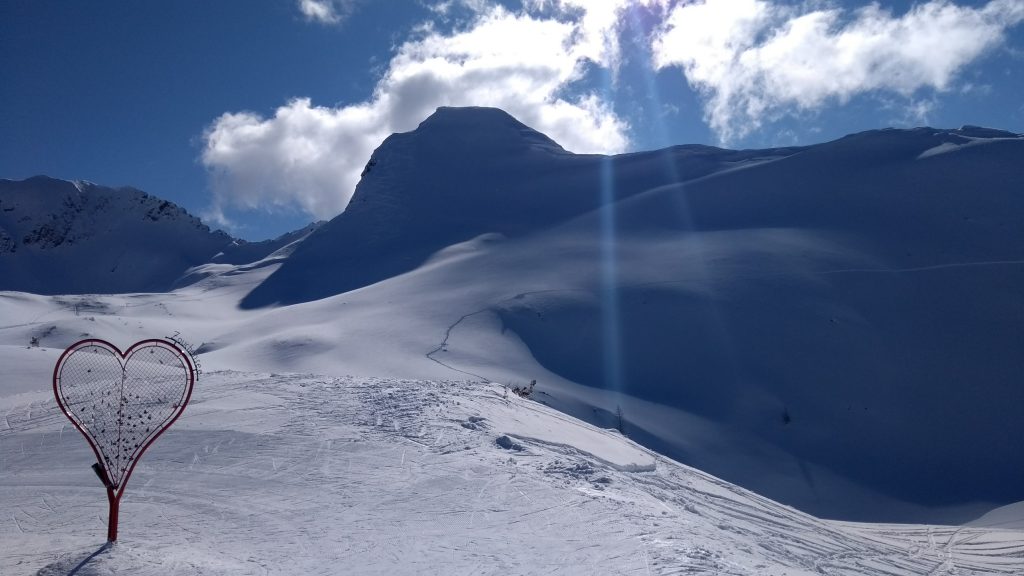
Left: boring piste. Right: GLORIOUS POW and summits
Downhill skiing can be a lot of fun, but it does have its issues. The pistes can be dangerously overcrowded at times – picture a road where you have to drive downhill on sheet ice with other cars swarming around you trying to overtake at high speed (some of them driven by kids, who have no concept of risk), and that’s pretty much your average ski piste in February! And over the last few years I’ve started to find it harder to justify my ski trips – there is such a huge environmental cost involved with ski resorts (from artificial snowmaking and the electricity required to run the lifts, to the destruction of landscapes and habitats through avalanche clearance and piste building). I realise having just come back from a ski holiday I’m being a complete hypocrite here, but this is something that’s been on my mind for a while.
Ski touring – where you attach grippy ‘skins’ to touring skis so you can slog up the mountain on skis before skiing back down again – seems much more in the UBES spirit of doing things. It lets you access far more remote terrain, opens up new expedition possibilities, and has a much lower environmental impact.* Sadly, I haven’t been able to try it out yet (I’ve missed so many chances to do beginner’s courses, it’s ridiculous!) but I’m keen to get some UBESters ski touring in Scotland next year – quite a few instructors there run affordable courses. Also note that if you have two years’ continuous membership of the AAC you’re eligible to apply for their training grants for up to 50% off the cost of Alpenverein snowshoe and ski touring training courses in Austria, or for selected winter courses (off piste skiing, avalanche awareness etc) at Glenmore Lodge in Scotland. Yet another reason to join the AAC, folks…Note: for those of you new to skiing, you do need some skiing experience before you start ski touring – skiing through powder is a lot harder than on the piste and obviously you’re further away from help if you do have an accident. So get started learning on a dry slope now!
With the good snow conditions in Scotland this season, people have been out on some absolutely epic tours – check out the British Backcountry Facebook group if you want an unlimited procrastination source. For more ski touring psyche check out the blog of UBES alumnus and veteran expeditioner, George Cave. He’s recently moved out to Austria and has been making the most of the mountains nearby. You can also read about his trip skiing Mt Damavand in Iran! Finallly, a great Austrian blog to follow is Berghasen – the blog is all in German but it’s packed full of route ideas and beautiful mountain photos. Vroni and Susi, the two ladies who run the blog, are out in the mountains near Salzburg several times a week and have been doing a lot of ski touring this winter – their Instagram is awesome (but also pure torture when you’re sat at your desk)!
* Admittedly, part of ski touring’s attraction is that there’s far fewer people doing it so you can still find quiet routes. If everyone ditched downhill skiing overnight to swap to touring it might not be such a tranquil experience! And in many ski resorts downhill skiing is crucial to the economy – almost all the residents will earn their living from the ski tourists, from the lift operators and engineers to restaurant staff, ski instructors, ski rental shop assistants…So I’m not trying to completely write off downhill skiing here! I don’t have the answers, but I have most certainly started questioning it…
Cross-Country Skiing
Another type of skiing worth a try (and sometimes confusingly also referred to as ski touring!) is cross-country skiing, or Langlauf. Instead of going up the mountain to ski down, with cross-country you generally stay on the flat or in areas with gentle hills, but don’t let that fool you into thinking it’s easy. It’s one of the most physically-demanding sports out there, especially over the long distances normally covered in races – you might have seen competitors collapsing at the finish line in the cross-country events at the Winter Olympics! So prepare to wake up feeling like you’ve been run over by a truck after your first day of cross-country skiing. But it’s fantastic for your fitness and is also A LOT cheaper than downhill skiing – you don’t need a lift pass and many mountain towns have well-maintained Loipe (cross-country ski routes) networks which you can ski for free. Occasionally you need to buy a Loipe pass, but it’s always a lot cheaper than a lift pass. Cross-country skis are thinner and lighter than downhill skis, and the boots are SO much comfier, so you can be smug and laugh at all the downhill skiers trudging back from the lifts in their clumpy boots, arms killing them dragging their skis along.
My favourite aspect of cross-country is that the Loipe tracks are so much quieter than the pistes – you can really enjoy the scenery and stop to take photos whenever you want without worrying someone is going to crash into you at 60kph. Unless you stop at the bottom of a hill, because going downhill is really rather ‘suboptimal’ on cross-country skis. And by that I mean as a beginner it’s almost impossible to stop, so you may well have a few close encounters with rivers! But in all seriousness, it’s not that hard – you can just hire the equipment and set off, you don’t really need lessons. Thinking on it, maybe that’s why I had the close encounters with rivers…
Note there’s two different types of cross-country skis: classic skis, which are designed for skiing within the Loipe tracks (like skiing on rails), and skate skis, which are designed for skiing faster outside the tracks in a skating motion (this is the type you’ll have seen in the Winter Olympics). There are Loipe pretty much everywhere in Austria (check out this giant list!), but the king of all the areas is Ramsau am Dachstein where the pros come to train. It has 220km of tracks, including routes up on the Dachstein glacier at 2700m.
Avalanche Safety
At the start of the winter the Alpenverein toured Austria with their Lawinen (avalanche) Update lecture series. The lecture was fascinating and far more in-depth than I expected! If you do speak German, a recording of an Avalanche Update lecture is available here (part 1) and here (part 2). If you don’t, don’t be tempted to try following along with the automated English subtitles – they’re dreadful! I’m planning to put together a UBES avalanche safety guide soon combining SAIS’ advice with some of the excellent German-language advice out there, but as a quick taster, one of the main points they focused on was slope gradient. This gets mentioned as part of our Scottish winter skills training, but we don’t focus on it to the same extent as the Alpenverein do because with winter hiking you’re normally on gentler slopes. In contrast, when you’re skiing or climbing you deliberately seek out the steeper slopes which are at higher risk of avalanche – gullies are the classic example.
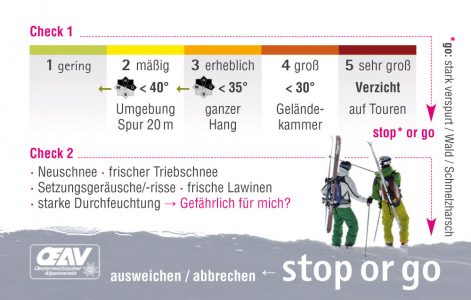
Stop or Go info card. Image credit: Alpenverein.
The Alpenverein’s main avalanche safety campaign is called ‘Stop or Go’ and the info card to the left shows its key points. To translate the card: if the avalanche forecast is at level 1, the risk is low and you can go out on slopes at any gradient you can safely climb/ski. Other good ‘go’ indicators are if the snow is very tracked out by other skiers (not just one set of tracks, but many), if you’re in forest, or if the forecast says the snowpack is very well consolidated after cycles of freeze-thaw. If the forecast is at level 2, the area around you (within 20m) should be below 40°; at level 3, the whole slope you’re skiing should be below 35°; at level 4, you want all the terrain around you to be below 30° as the risk of natural avalanches (i.e. avalanches happening even on slopes you don’t walk/ski on) is now high; and at level 5, just don’t go out in the mountains, stay in and drink hot chocolate instead! The other risk indicators they list to watch out for are exactly what you look out for on winter skills: fresh unconsolidated snow, wind slab, the snow squeaking or ripping into chunks as you step on it, evidence of recent avalanches in the area, and wet snow (after rain or warm temperatures). Finally, it’s important to note that everyone in your group should have LVS-Ausrüstung (avalanche equipment i.e. transceiver, shovel, probe) with you and know how to use it. They also recommend you ski with a backpack that has an avalanche airbag. I haven’t got space to cover avy gear in detail here, but I’ll be talking about it in the avalanche safety guide. And whether we should also have that gear with us as winter hilllwalkers is a whole different debate…Below are some example maps with the slope gradients shown – to check these out for yourself, go to Outdooractive and make sure you enable the Winter map and Hangneigung (slope gradient) layer.
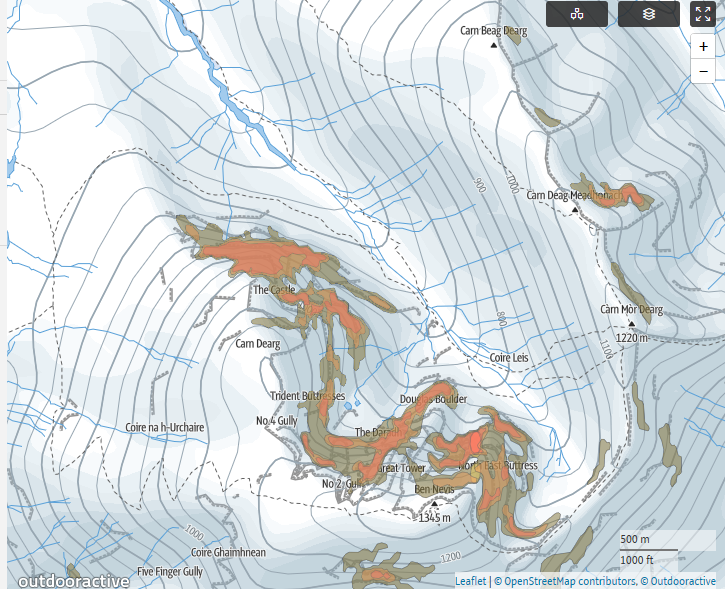
The slope gradients shown for Ben Nevis. Most classic hillwalking routes avoid the risky >30° terrain – for example you can see here that the CMD route (up Carn Mor Dearg on the path from the north, around the CMD ridge to Ben Nevis summit, down the Tourist Track and back around into the valley) is all unshaded. But if you’re looking at winter climbing or ski touring in this area then you might be targeting some of the shaded terrain and you need to take the added risk into account. Image credit: Outdooractive.
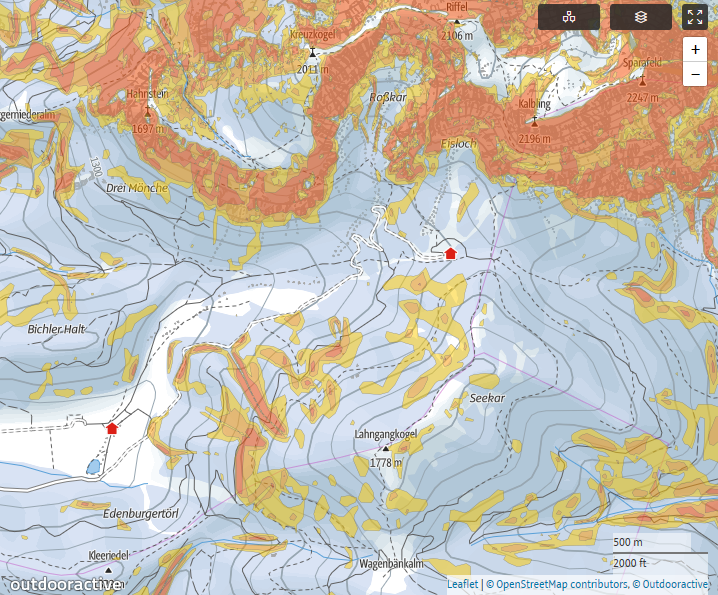
The slope gradients for the Lahngangkogel where I went snowshoeing. Our route took us from near the hut on the left through the unshaded (i.e. not >30°) terrain to the Wagenbankalm, then up to the Lahngangkogel, along the path (invisible on the ground) round to the second hut (the Oberst-Klinke) and back to the hut on the left. The avalanche risk was 2 where we were below the treeline and the snow was fairly well consolidated, so this route followed the Stop or Go guidelines as we didn’t pass through any terrain >40° (in dark orange). However, if we’d headed directly east from the left-hand hut instead of detouring to the Wagenbankalm, we could easily have ended up in that kind of terrain. Note: this area is known for being pretty low-risk, which is why we chose it for our first time snowshoeing. Many mountain areas in Austria are A LOT steeper – like the cliffs you can see at the top of the map! Image credit: Outdooractive.
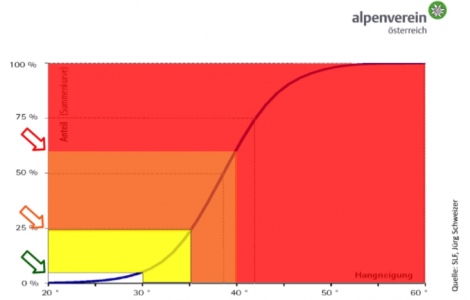
Of course, the Stop or Go guidelines don’t completely eliminate risk – there have still been cases of people being caught out in avalanches despite playing by all the rules. But they do massively reduce your risk of being caught in an avalanche. This graph shows the percentage of avalanches which occur at or below the given gradients; as you can see, only 25% of recorded avalanches happen on slopes below 35° (the yellow shaded area in the graph), so if you stick to those you’re cutting out a massive chunk of the risk. Apologies for the poor image quality, this is a screenshot straight from the lecture! Image credit: Alpenverein.
Winter in Graz
Graz and southern Styria are known for having a milder climate than most of Austria, so we haven’t exactly been buried in snowdrifts…In fact it’s only snowed a few times all winter in the city! But, like the rest of Europe, Graz has been hit by the BEAST from the EAST (say it super dramatically like a BBC newsreader trying to cause snow panic) recently, so has seen a healthy amount of snow and temperatures down to -20°C. The lake at Hilmteich is fully frozen over and open for ice skating, and there’s 11km of Loipe tracks open in nearby Thal. But all winter long there’s been snow about in the nearby hills such as the Schöckl (Graz’s local mountain – 1445m) and the Hohe Rannach (1018m), which I hiked with friends from Erasmus in January. Both days were a lot of fun, but there’s still a few things about hiking in Austria that I’m struggling to get used to. Having signposts and cafes serving heiße Schokolade and Kaiserschmarrn near the summit of something higher than Ben Nevis is just bizarre, and the endless trees wreak havoc with my nav (we may or may not have ended up walking in a circle trying to get to the summit of the Hohe Rannach…)


